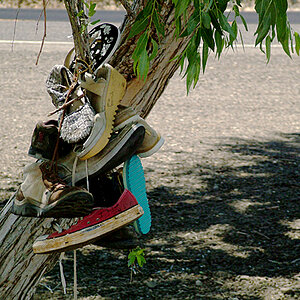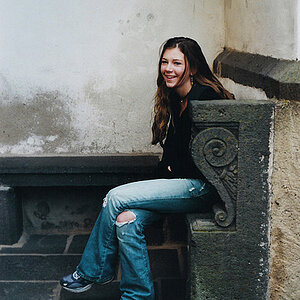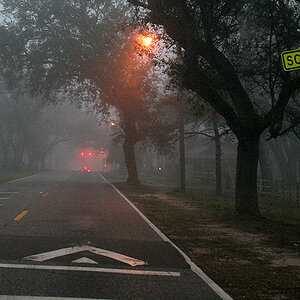Orrin
No longer a newbie, moving up!
Composition is the arrangement of elements in a photograph. These elements include line, shape, space, and tone or color. Composition has no fixed rules because it is basically a matter of individual taste. However, some guidelines for the use of the various elements of composition may help you create the kind of photograph desired.
There are two principal kinds of lines in photography, real lines and implied lines. Real lines are physically visible. For example, telephone poles and the edges of buildings form real lines. Implied lines are created by nonphysical factors, such as a pointing gesture or a person's gaze.
Both real lines and implied lines can be used to direct a viewer's eye to various parts of a picture. In most effective photographs, the lines draw attention to the main subject. The
direction of these lines can also be used to reinforce the mood of a picture. Vertical lines, such as those of a tower or a tall tree, may convey a sense of dignity and grandeur. Horizontal lines tend to suggest peace and stillness, and diagonal ones may emphasize energy and tension.
Shape is the chief structural element in the composition of most photographs. It enables the viewer to immediately recognize the objects in a picture. Shape also adds interest to composition. The shape of such objects as rocks and seashells is interesting in itself. A combination of different shapes provides variety. For example, an outdoor scene can be made more interesting by contrasting the jagged shape of a fence with the soft curves of
hills and clouds.
Space is the area between and surrounding the objects in a photograph. Space can be used to draw attention to the main subject and to isolate details in the picture. However, large amounts of space tend to detract from a picture's interest. A general principle for the use of space is that it should not occupy more than a third of the photo.
Tone or color adds depth to the composition of a photograph. Without this element, the shapes and spaces in a picture would appear flat. In black-and-white photography, the colors of objects are translated into tones of black, gray, and white. These tones help establish the mood of a picture. If light tones dominate the photo, the mood may seem happy and playful. A picture with many dark tones may convey a sense of sadness or
mystery.
Color, like tone, carries an emotional message. In a color photograph, such bright colors as red and orange create an impression of action and energy. Blue, green, and other softer
colors are more restful to the eye and may suggest a feeling of peace. According to many professional photographers, a color picture should have one dominant color and a balance between bright colors and softer shades.
There are two principal kinds of lines in photography, real lines and implied lines. Real lines are physically visible. For example, telephone poles and the edges of buildings form real lines. Implied lines are created by nonphysical factors, such as a pointing gesture or a person's gaze.
Both real lines and implied lines can be used to direct a viewer's eye to various parts of a picture. In most effective photographs, the lines draw attention to the main subject. The
direction of these lines can also be used to reinforce the mood of a picture. Vertical lines, such as those of a tower or a tall tree, may convey a sense of dignity and grandeur. Horizontal lines tend to suggest peace and stillness, and diagonal ones may emphasize energy and tension.
Shape is the chief structural element in the composition of most photographs. It enables the viewer to immediately recognize the objects in a picture. Shape also adds interest to composition. The shape of such objects as rocks and seashells is interesting in itself. A combination of different shapes provides variety. For example, an outdoor scene can be made more interesting by contrasting the jagged shape of a fence with the soft curves of
hills and clouds.
Space is the area between and surrounding the objects in a photograph. Space can be used to draw attention to the main subject and to isolate details in the picture. However, large amounts of space tend to detract from a picture's interest. A general principle for the use of space is that it should not occupy more than a third of the photo.
Tone or color adds depth to the composition of a photograph. Without this element, the shapes and spaces in a picture would appear flat. In black-and-white photography, the colors of objects are translated into tones of black, gray, and white. These tones help establish the mood of a picture. If light tones dominate the photo, the mood may seem happy and playful. A picture with many dark tones may convey a sense of sadness or
mystery.
Color, like tone, carries an emotional message. In a color photograph, such bright colors as red and orange create an impression of action and energy. Blue, green, and other softer
colors are more restful to the eye and may suggest a feeling of peace. According to many professional photographers, a color picture should have one dominant color and a balance between bright colors and softer shades.


![[No title]](/data/xfmg/thumbnail/42/42460-80970c44cc9fb42dd0c86d08e7bc401d.jpg?1619740191)
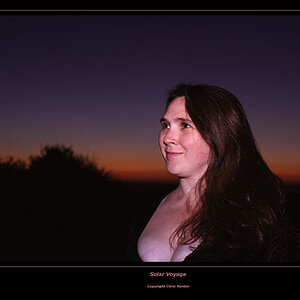
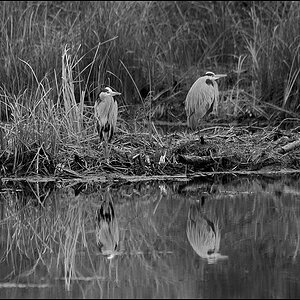


![[No title]](/data/xfmg/thumbnail/32/32153-05f63098d8752b05df53dfa6ae8d6e7d.jpg?1619735234)
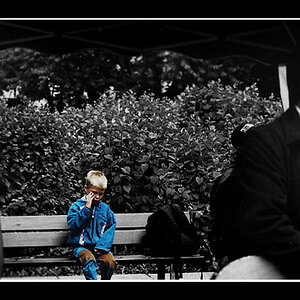
![[No title]](/data/xfmg/thumbnail/42/42458-8274869c9294d2f0655f80c8f0e6048c.jpg?1619740191)

